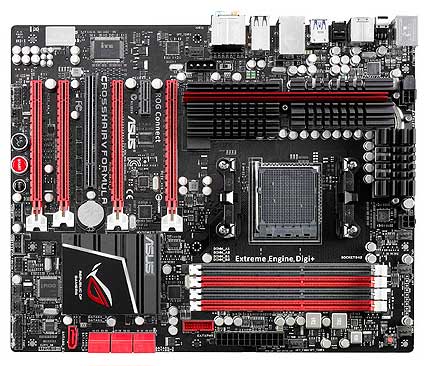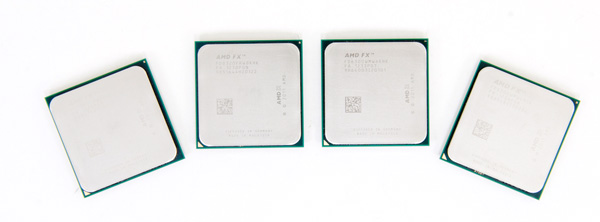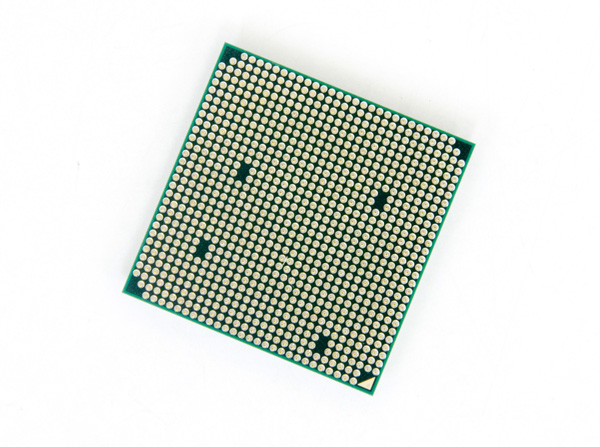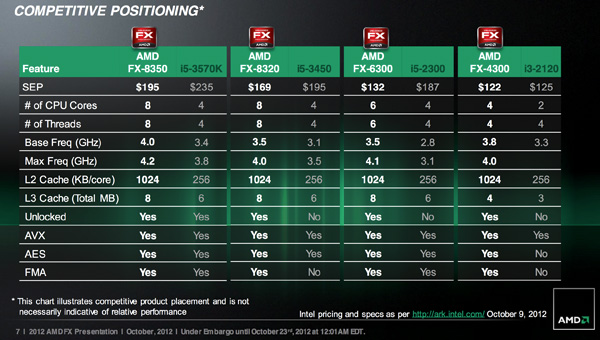The Vishera Review: AMD FX-8350, FX-8320, FX-6300 and FX-4300 Tested
by Anand Lal Shimpi on October 23, 2012 12:00 AM ESTLast year's launch of AMD's FX processors was honestly disappointing. The Bulldozer CPU cores that were bundled into each Zambezi chip were hardly power efficient and in many areas couldn't significantly outperform AMD's previous generation platform. Look beyond the direct AMD comparison and the situation looked even worse. In our conclusion to last year's FX-8150 review I wrote the following:
"Single threaded performance is my biggest concern, and compared to Sandy Bridge there's a good 40-50% advantage the i5 2500K enjoys over the FX-8150. My hope is that future derivatives of the FX processor (perhaps based on Piledriver) will boast much more aggressive Turbo Core frequencies, which would do wonders at eating into that advantage."
The performance advantage that Intel enjoyed at the time was beyond what could be erased by a single generation. To make matters worse, before AMD could rev Bulldozer, Intel already began shipping Ivy Bridge - a part that not only increased performance but decreased power consumption as well. It's been a rough road for AMD over these past few years, but you have to give credit where it's due: we haven't seen AMD executing this consistently in quite a while. As promised we've now had multiple generations of each platform ship from AMD. Brazos had a mild update, Llano paved the way for Trinity which is now shipping, and around a year after Zambezi's launch we have Vishera: the Piledriver based AMD FX successor.
At a high level, Vishera swaps out the Bulldozer cores from Zambezi and replaces them with Piledriver. This is the same CPU core that is used in Trinity, but it's optimized for a very different purpose here in Vishera. While Trinity had to worry about working nicely in a laptop, Vishera is strictly a high-end desktop/workstation part. There's no on-die graphics for starters. Clock speeds and TDPs are also up compared to Trinity.
| CPU Specification Comparison | ||||||||
| CPU | Manufacturing Process | Cores | Transistor Count | Die Size | ||||
| AMD Vishera 8C | 32nm | 8 | 1.2B | 315mm2 | ||||
| AMD Zambezi 8C | 32nm | 8 | 1.2B | 315mm2 | ||||
| Intel Ivy Bridge 4C | 22nm | 4 | 1.4B | 160mm2 | ||||
| Intel Sandy Bridge E (6C) | 32nm | 6 | 2.27B | 435mm2 | ||||
| Intel Sandy Bridge E (4C) | 32nm | 4 | 1.27B | 294mm2 | ||||
| Intel Sandy Bridge 4C | 32nm | 4 | 1.16B | 216mm2 | ||||
| Intel Lynnfield 4C | 45nm | 4 | 774M | 296mm2 | ||||
| Intel Sandy Bridge 2C (GT1) | 32nm | 2 | 504M | 131mm2 | ||||
| Intel Sandy Bridge 2C (GT2) | 32nm | 2 | 624M | 149mm2 | ||||
Vishera is still built on the same 32nm GlobalFoundries SOI process as Zambezi, which means there isn't much room for additional architectural complexity without ballooning die area, and not a whole lot of hope for significantly decreasing power consumption. As a fabless semiconductor manufacturer, AMD is now at GF's mercy when it comes to moving process technology forward. It simply has to make 32nm work for now. Piledriver is a light evolution over Bulldozer, so there's actually no substantial increase in die area compared to the previous generation. Cache sizes remain the same as well, which keeps everything roughly the same. These chips are obviously much larger than Intel's 22nm Ivy Bridge parts, but Intel has a full node advantage there which enables that.
Piledriver is a bit more power efficient than Bulldozer, which enables AMD to drive Vishera's frequency up while remaining in the same thermal envelope as Zambezi. The new lineup is in the table below:
| CPU Specification Comparison | ||||||||||
| Processor | Codename | Cores | Clock Speed | Max Turbo | L2/L3 Cache | TDP | Price | |||
| AMD FX-8350 | Vishera | 8 | 4.0GHz | 4.2GHz | 8MB/8MB | 125W | $199 | |||
| AMD FX-8150 | Zambezi | 8 | 3.6GHz | 4.2GHz | 8MB/8MB | 125W | $183 | |||
| AMD FX-8320 | Vishera | 8 | 3.5GHz | 4.0GHz | 8MB/8MB | 125W | $169 | |||
| AMD FX-8120 | Zambezi | 8 | 3.1GHz | 4.0GHz | 8MB/8MB | 125W | $153 | |||
| AMD FX-6300 | Vishera | 6 | 3.5GHz | 4.1GHz | 6MB/8MB | 95W | $132 | |||
| AMD FX-6100 | Zambezi | 6 | 3.3GHz | 3.9GHz | 6MB/8MB | 95W | $112 | |||
| AMD FX-4300 | Vishera | 4 | 3.8GHz | 4.0GHz | 4MB/4MB | 95W | $122 | |||
| AMD FX-4100 | Zambezi | 4 | 3.6GHz | 3.8GHz | 4MB/4MB | 95W | $101 | |||
The table above says it all. TDPs haven't changed, cache sizes haven't changed and neither have core counts. Across the board Vishera ships at higher base frequencies than the equivalent Zambezi part, but without increasing max turbo frequency (in the case of the 8-core parts). The 6 and 4 core versions get boosts to both sides, without increasing TDP. In our Trinity notebook review I called the new CPU core Bulldozed Tuned. The table above supports that characterization.
It's also important to note that AMD's pricing this time around is far more sensible. While the FX-8150 debuted at $245, the 8350 drops that price to $199 putting it around $40 less than the Core i5 3570K. The chart below shows where AMD expects all of these CPUs to do battle:
AMD's targets are similar to what they were last time: Intel's Core i5 and below. All of the FX processors remain unlocked and ship fully featured with hardware AES acceleration enabled. Most Socket-AM3+ motherboards on the market today should support the new parts with nothing more than a BIOS update. In fact, I used the same ASUS Crosshair V Formula motherboard I used last year (with a much newer BIOS) for today's review:

The Test
For more comparisons be sure to check out our performance database: Bench.
| Motherboard: | ASUS Maximus V Gene (Intel Z77) ASUS Crosshair V Formula (AMD 990FX) |
| Hard Disk: | Intel X25-M SSD (80GB) Crucial RealSSD C300 OCZ Agility 3 (240GB) Samsung SSD 830 (512GB) |
| Memory: | 4 x 4GB G.Skill Ripjaws X DDR3-1600 9-9-9-20 |
| Video Card: | ATI Radeon HD 5870 (Windows 7) NVIDIA GeForce GTX 680 (Windows 8) |
| Desktop Resolution: | 1920 x 1200 |
| OS: | Windows 7 x64/Windows 8 Pro x64 |













250 Comments
View All Comments
Granttamaid - Tuesday, June 11, 2013 - link
Remember Price vs performance, AMD always win against intel. Well, intel has the fastest processor in the world,.... but, do you need all the intel's potential power? i don't think so.some people only use their computer for internet browsing even they have intel core i7.
pantong - Monday, July 8, 2013 - link
I see most comments talking about how this card is shit.Sigh.
This card works great for what I need it to do. I host 7 servers on my computer on v boxes for my gaming community. Mine craft, ts, star made, cube world, ect... I don't get paid for my services and I need it cheap. This card give performance to host a lot of people on each on each core. From a low 4 people on cube world to 45+ on team speak.
Why would I buy Intel for these purposes other than to spend money for same performance in the scenario and flaunt my epeen.?
Performance is not based on score or GHz. Its based on money.
So before saying this card is shit. Why not look at multiple applications that this card can be used it.
As far as this scenario goes. Any unused CPU is lost money.
Ukdude21 - Thursday, August 15, 2013 - link
You keep complaining about amd fanboys, but your obviously an intel fanboy... You sound completely immature with your constant us of LOL in caps.No need to get too excited about cpu's... They are just part of a machine that you use lol.
Seriously you should not post on this website if you are just going to be a immature intel fanboy.
You sound too young to be posting on this website anyways.
"obnoxious insolence" you should re-read your post as it is completely obnoxious.
Your attitude stinks -.-
Gholt - Thursday, August 29, 2013 - link
All those Intel & AMD Fanboys.. Holy crap -_-I have an FX-8350 and had an i7 in the past.
I went for the FX-8350 since it was so much cheaper compared to the i7 3770K while having almost identical performance, AMD just can't be beaten by their Price-Performance products, however Intel's best CPU's will Always be better than AMD's best, thats a fact to be known.
BUT, that doesnt make AMD bad, like all these Intel ''Fanboys'' seem te think, Intel and AMD are both bad and good in their own way, get the fuck over it both you AMD AND Intel fanboys.
alcomenow - Friday, October 11, 2013 - link
If you live in a hot and humid climate an FX processors would be a terrible value. Most people that live in central Florida use air-conditioning 80% to 90% of the year. For my uses the equivalent AMD CPU's have been tested and shown to consume about 65 watts more under full load and 11 watts under idle conditions than a comparable Intel CPU. Since I pay 100% of the electrical bill then buying a Intel CPU will become a significant cost saving purchase over 4 or 5 years.Well, 10 or 50 watts might not seem like it would cost much. If you factor in daily usage, a/c cost, and 4 years of ownership than the pennies start to add up.
1w * 12hrs/day = 4.3kw/hrs/yr
4.3kw * 0.8 a/c cost = 7.7kw * $0.11 kw/hrs = $0.85 yr
$0.85 * 4 yr = $3.40 per watt
example $3.40 * 30w = $102
1w * 24hrs/day = 8.6kw/hrs/yr
8.6kw * 0.8 a/c cost = 15.4kw * $0.11 kw/hrs = $1.7 yr
$01.7 * 4 yr = $6.80 per watt
example $6.80 * 50w = $340
If I was building someone a budget gaming desktop, I would recommend spending $130 on a Intel Core i3-3225 Ivy Bridge 3.3GHz LGA 1155 55W Dual-Core Desktop Processor Intel HD Graphics 4000 running at stock speeds instead of spend $120 on a AMD FX-6300 Vishera 3.5GHz (4.1GHz Turbo) Socket AM3+ 95W Six-Core Desktop Processor even if overclocked to 4GHz.
ToeringsNthong - Saturday, January 11, 2014 - link
Quote""Single threaded performance is my biggest concern, and compared to Sandy Bridge there's a good 40-50% advantage the i5 2500K enjoys over the FX-8150"I know this is an old post BUT i just bought its big bother the FX 8350 for $129.99 ,and they are saying the same thing,poor single thread performance.I say WHO CARES? I know most people that have 1/2 a brain don't care!! Most people buy this CPU for gaming !What games can you name are single threaded???unless you go back to the stone age ! and are playing the very 1st battlefield 1942?thats all i do is game and transcode videos and dollar to dollar this thing kicks intels a s s! so case closed!!!! AMD all the way FTWmersastra - Thursday, January 16, 2014 - link
1st time in ages pondering an upgrade , why I don't know as what I have doe's everything i need to , I don't game by the way. Sitting on Phenom11 Quad 965 Black Edition , gently O/c to 3.7ghz . Asus M4A88TD-evo with 16GB of memory. Not impressed with bench marks in the least , used to laugh at them with lenses when I used to do photography , meaningless in the real world mostly. pondering this chip , currently about £143. Been building machines since 286 days and always use AMD , never let me down , have been with several Intel ones. If AMD went bust leaving Intel with a monopoly, would price out of our reach. My thoughts anyway. Not really bothered which chip as long as it works , each to their own , don't understand the squabbling. lol.LBJ - Saturday, January 18, 2014 - link
Did you look at the games benchmarks in this review? It's not that games only use a single thread, it's that plenty of games are no optimised well for multi-threaded CPUs. If we're talking about BF4 fine, the FX chips will perform well against Intel, but it's clear from these benchmarks that in plenty of titles from the past few years that the poor per-core performance of the AMD chips does hamper its gaming potential.Chromatose - Sunday, February 2, 2014 - link
And the fanboyism repeats itself again.... AMD is slowly creeping up to Intel, eventually they would have to be equal. AMD does good at 3D modelling, video editing and gaming, Intel is suited more for video editing, rendering and graphics. AMD is low price and value. If you can OC it properly and with good cooling, it beats Intel in SOME areas. Intel, on the other hand, can deliver a tad more power with lower clock speeds.AMD has less framerate from Intel, but only a *slight* difference in performance. AMD is known to have weak cores and make it up by adding 8. Intel has slightly more power in each core, but mainly goes up to 6 cores.
My conclusion? AMD should stop fighting with Intel and slowly work their way up from there.
Melcinitan - Thursday, June 19, 2014 - link
Ok people,lets just agree that nothing is free of charge.We HAVE TO PAY to get these badboys on our pcs so you can stop bitchin about "price dont matter".AMD FX 8320 is around 160$.lets check for the same price to intel right?Intel - Core i3 Dual-core i3-4340 is what i found on the net after a quick search. If you tell me that i3 guy can best FX 8320 than yep Intel is the winner.But if you try to compare i7 and this fx guy,thats wrong.
I think amd tries to sell cpus to middle-class folks who only wants to have best performance with a weak salary and Intel is trying to do the best of the bests regarding how much it will cost. If you have lots of money buy an intel and have fun of it. If you dont have that much money but still need some performance go for AMD.
My opinion is giving half the money and have a tick less of performance.I'll live.